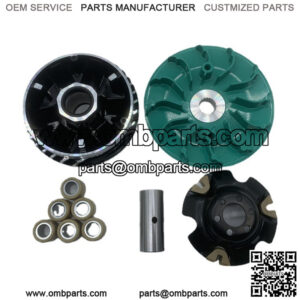A Clutch’s Lifecycle
Before figuring out how long a clutch should last, it is important to understand how this vital component works. After all, many changes have occurred since the advent of cars in the late 1800s. Even in today’s market, we still have many vehicles ranging from vintage roadsters to automatic 4x4s. Each has its own clutch assembly type and mechanism – and consequently, differing pain points affecting longevity and mileage.
How Exactly Does a Clutch Work?
In general, clutches connect two rotating shafts – one of them driven by a motor or pulley. These shafts either spin at the same speed when locked together or spin at different speeds when decoupled.
Traditional clutches usually consist of these main components (although other assemblies may have some missing items):
- Clutch Disc/Plate – connects to the transmission
- Pressure Plate – connects to the clutch disc
- Flywheel – connects to the engine
- Mechanical or Hydraulic Release Mechanism – either cable or shaft-and-lever style
- Cable – connects between clutch pedal and fork
- Linkage – connects the clutch fork to the pressure plate
- Pilot Bearing – connects input shaft and clutch disc
- Release/Throw-out Bearing
- Clutch Fork – modulates force between pressure plate and clutch via linkage
The ability to affect the movement of the rotating shafts (through a clutch pedal) allows clutches to modulate the amount of torque and power supplied to the engine. More importantly, it enables the wheels to function separately from the power mill (through the friction of the flywheel and the clutch disc), allowing gearshifting and a complete halt of the vehicle even when the engine is still running.
Basic Friction Clutch
This clutch type has similar components as above and is operated hydraulically or via cable. It engages or disengages the flywheel and transmission using a pressure plate, a single/multiple clutch plate/disc, and a release bearing. The release bearing, in particular, applies pressure to the diaphragm springs on the pressure plate, consequently releasing clamping pressure on the clutch plate and disengaging the transmission from the flywheel.
Wet and Dry Clutches
Most vehicles employ a single-plate friction clutch characteristic of a dry clutch and come with no oil supply, given its considerable coefficient of friction. It transmits power from the gearbox to the wheels without fail – unless the clutch disc wears thin (usually accompanied by a scratching noise). This setup often comes with dampers that stop vehicle vibrations from damaging the clutch when changing gears.
High-powered engines require a multi-plate clutch characteristic of a wet clutch type to engage the transmission effectively. Additionally, this setup has a supply of oil to lubricate and cool components prone to overheating.
Wet clutches generally last longer and are preferred in high torque situations or any powertrain with over 338.9 Nm (250 ft-lb) of torque over dry clutches. Plus, you can tell a wet clutch is faulty by the presence of contaminants or a burnt smell in the lubricant.
Automatic Torque Converter or ATCs
ATC is one of the three types of clutches found in automatic cars and directly connected to a car’s ECU or Engine Control Unit. With this setup, wheel rotation (torque) increases to a point where it automatically engages the clutch and changes gear despite the absence of a clutch pedal. Porche’s Tiptronic Transmission offering manual and automatic gear selection modes somewhat fall under this category.
Dual Clutches or DCTs
First released through the Volkswagen Mk4 Golf R32, this clutch-type currently dominates the premium car market. You will find many supercars and saloons making use of a large multi-plate clutch for odd gears and a smaller multi-plate clutch for even gears – ensuring no break in output and eradicating the need for a torque converter.
Direct Shift Gearbox or DSGs
Sharing a similar setup with DCTs, a Direct Shift Gearbox (DSG) utilizes two clutches that disengage alternately in changing gears, offering quick-shifting, smoother acceleration, and better fuel efficiency versus manual gearboxes. It is a wet transmission type guaranteed to provide decades of service, provided its fluid is inspected and changed regularly.
Electromagnetic Clutches
Electromagnetic clutches go beyond the normal clutch operation and are actuated by pressing a proximity sensor or a button on the gearstick. It then allows DC current to pass through an electromagnet, producing a magnetic field. A frictional force engaging the engine and transmission is then produced due to the rotor attracting the armature.
Electromechanical Clutches
Electromechanical clutches make use of a combination of electrohydraulics and DCTs, making them one of the smoothest clutch systems around. They are also used in paddle-shift systems, which have paddles on the side of the steering wheel causing electrical signals to send to a computer engaging a servo. The entire process allows disengaging the clutch hydraulically and changing gears in semi-automatic cars.
How Long Does a Clutch Last?
Given the many types of clutches and transmission they pair with, there is really no established timeframe or mileage until when they will last or when to change them. Its lifespan depends on several variables, such as driving habits, start-stop traffic, vehicle usage, climate, and servicing (among others) – all of which can lead to sudden or gradual clutch failure.
On average, a clutch lasts from 30,000 to 100,000 miles. However, the failure of individual components (which differ from one another) shorten its longevity. For instance, a clutch disc/plate can last up to 60,000 miles, a pilot bearing 65,000 miles, and a flywheel up to 100,000 miles before warranting change. Pressure plates and release/throw-out bearings may require less time for a replacement or as soon there are problems or signs of slipping.
At best, a well-maintained clutch can last up to 170,000 miles. Worst-case scenario, it could take fewer than 10,000 miles before becoming defective – especially if the vehicle is pre-owned or has not received proper upkeep. Older models, RVs, cars used to pull trailers, or those ridden in hotter climates do not hold out for very long against those used for daily commute and in locations with cooler weather.
Spotting Signs of a Bad Clutch
Given the timeframe a clutch is guaranteed to properly function, timely intervention is crucial. You need a good eye for spotting bad clutch symptoms that may hinder your clutch from lasting as long as it should. These indicators can go from noises to poor engine performance to unusual clutch pedal behavior. Let us break down each of these symptoms in this section:
Slipping Clutch
Observing some irregularity when shifting between gears means the clutch is disengaged with no power delivered to the wheels – an occurrence referred to as a slipping clutch. Typically, it is accompanied by a faint judder, scratching or squeaking noises, stickiness of the clutch pedal, or difficulty in gear selection despite achieving the appropriate level of revs for a gear change (RPMs rise beyond what is required).
These symptoms often overlap with other clutch problem indicators. Other scenarios indicating a slipping clutch include:
- Loose/depressed/spongey pedal when in gear
- Defective accelerator pedal
- Unusual sensitivity in the clutch pedal, especially in areas where you need to change gears a lot
The above (non-exhaustive) list stem from several potential causes, as follows:
- Air in the hydraulic line or low fluid in the reservoir
- Broken motor mounts
- Center valve seal fault or piston primary seal leak in the master cylinder
- Leaking hose, pipe, or connection
- Misaligned, bent, or damaged clutch linkage
- Mismatched clutch components and aftermarket parts
- Oil-contaminated clutch assembly
- Stretched or binding clutch linkage or cable or corroded cable housing
- Warped pressure plate
- Unnecessary pressure buildup caused by leaky or defective slave/master cylinders
Any of the following root causes would indicate your clutch is shot. If not addressed immediately, the defective clutch will continue to turn the input shaft, resulting in grinding and preventing your vehicle from getting into gear. Hence, it is important to have your car looked into by a professional mechanic.
Difficulty in Shifting Gears
It is pretty easy to mistake increased difficulty in shifting gears to mean a slipping clutch. But unlike the latter, this problem is more consistent than intermittent and a sign of a damaged clutch. You can distinguish them by the amount of effort required to slot a gear into place. The harder it is to shift gears properly, the greater the damage sustained by the clutch.
With hydraulic clutches, the same signs would mean there are worn seals, some blockage, or air in the hydraulic system, resulting in gearshifting problems. Flushing out the system to get rid of trapped air is easy if you are mechanically savvy. It would also be worth checking the pedal linkage, clutch fork, pressure plate, throw-out bearing, cross shaft, or pivot ball for wear or insufficient lubrication in mechanical applications. Otherwise, asking for assistance from your local mechanic would be best.
Engine Shuddering
Grease or oil accumulation cause abnormal engine vibrations. They are more common with 4×4’s or other vehicles used to wade through shallow water crossings or waterlogged roads. The shaking could be negligible at first but may continually grow apparent, especially when changing gears at low speeds. Like gearshifting issues, a damaged clutch causes this problem and continues to persist if left unresolved for a long time.
Clutch Pedal Chattering or Pulsating
Vibrations in the clutch pedal when accelerating is another sign to watch out for, as this could mean that your clutch disc may be intermittently losing its grip on the flywheel. This loss of grip often traces back to the clutch disc lining being worn, glazed, burnt, or oil-contaminated. It could also relate to worn splines in the hub, warped flywheel or pressure plate, weak diaphragm springs, or damaged pilot bearings – among other things.
However, if you feel wobbling or pulsation right after servicing your vehicle’s transmission, double-check if your transmission housing properly aligns with the engine. You may find out it isn’t.
Higher Engine Revs But Poor Acceleration
This symptom mainly surfaces when attempting to overtake another vehicle or going uphill. It is at this time that an engine increases its revolutions and speed simultaneously. A car will be unable to do this if its clutch is worn, as the revs will not settle as quickly as they should in high gears.
Clutch Pedal Noises
Hearing noises when depressing or releasing the clutch pedal while the engine is off indicates a possible issue with the clutch release mechanism or clutch fork. Given that the clutch fork is a hydraulic or mechanical releasing device, it needs an ample amount of lubricant to operate smoothly. Otherwise, the lack of (or dried-out) lubricant will wear the release mechanism down. Conversely, the scraping of a cable, rod, or other connection in the clutch assembly may cause squeaking or clunking noises.
Whirling or Chirping
Sharp, chirping noises are specific to worn-out clutch release bearings. Conversely, whirling noises are trickier and can link to a faulty clutch, bad transmission, or worn input shaft bearings. You may notice hearing these sounds when releasing the clutch pedal while driving and going away after pressing the clutch again.
Grinding noises particularly point to problems with the pressure plate, throw-out bearing, or release mechanism. On a mechanical release system, the culprit could be a broken, frozen, or overstretched cable or one in need of adjustment. With hydraulic systems, the issue could be with a problematic clutch master cylinder or low clutch fluid. It could also mean an internal cylinder mechanism or clutch pedal assembly needing an adjustment or replacement.

